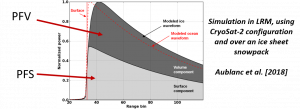As already described in the section dedicated to SMRT, and as illustrated below, the altimetry waveform measured over snow surface can be discriminated in two components:
- PFS(Power From Surface): the signal backscattered at snow/air interface
- PFV(Power From Volume): the signal backscattered by the snowpack, with two different origins:
- The scattering from snow grains within the snowpack (Pgrain)
- The backscattering from snowpack internal interfaces (Players)

Using the assets of both AltiDop and SMRT simulators, it is possible to simulate the global signal acquired over a snow surface:
- PFS is computed by AltiDop
- PFV is computed by SMRT. For now the PFV signal remains constant within the footprint, meaning that it doesn’t change from one facet to another.
The altimetry signal is constructed by adding the facets contribution to the corresponding altimetry waveform samples, according to:
- for the PFS signal: the facet/antenna distance (as explained in section 1)
- for the PFV signal: the facet/antenna distance + a time delay due to signal propagation into the snowpack.
The Figure below shows the general operating scheme of the AltiDop/SMRT simulator:

As stated in its dedicated section, SMRT can generate altimetry waveforms itself, without AltiDop. For that purpose, a module was implemented in SMRT to simulate the PFS signal using the Brown formulation. Considering that PFV signal is assumed to remain constant at any satellite incident angle (in the 0° – 0.6° range), the simulation of the final altimetry signal can be performed by a simple numerical convolution between PFS and PFV. In that fashion, SMRT is able to simulate altimetry waveform in LRM, when the surface is flat. Using the AltiDop + SMRT coupling, waveforms can be simulated in a large range of scene scenarii, with orbital variations, and most important: in all delay-Doppler modes (SAR unfocused, FF-SAR, LR-RMC). Subsequently it is possible to simulate waveforms in the planned CRISTAL configuration, in Ku/Ka, LRM/SAR.